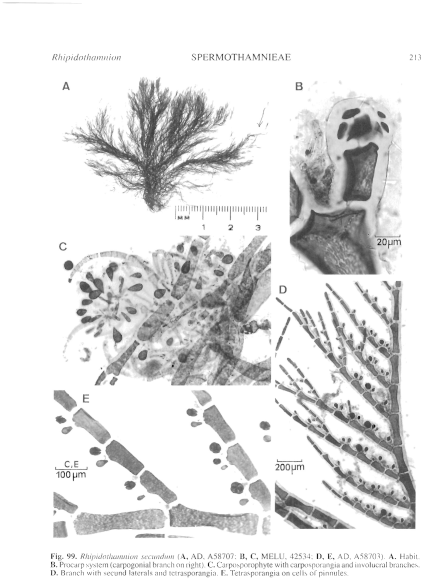|
|
|
|
|
|||||||||||
|
Electronic Flora of South Australia Species Fact Sheet
Phylum Rhodophyta – Order Ceramiales – Family Ceramiaceae – Tribe Spermothamnieae
Selected citations: Millar 1990: 397, fig. 45A–C. Millar & Kraft 1993: 42.
Thallus (Fig. 99A) medium red-brown, 0.5–7 cm high, much branched with strongly developed unilateral and secund branching, upper branches often curved, erect filaments arising from prostrate filaments. Attachment by digitate haptera from prostrate filaments; epizoic on bryozoans or mussels, epiphytic on algae, or epilithic. Structure. Prostrate filaments 65–90 (–120) µm in diameter with cells L/D 1.5–3, erect filaments tapering from 110–150 µm in diameter with cells L/D 2.5–7 near their base to 20–40 µm in diameter with cells L/D 3–5 several cells below the apices. Cortication absent. Cells multinucleate; rhodoplasts discoid.
Reproduction: Gametophytes dioecious. Female axes (Fig. 99B) apical on erect filaments, with 3 small cells, the subapical cell producing two sterile periaxial cells and the supporting cell bearing a sterile cell and a lateral carpogonial branch. Post-fertilization the carpogonial branch cells fuse and the auxiliary cell connects with the carpogonium via a connecting cell, producing up to four gonimolobes from a lobed fusion cell, with terminal ovoid carposporangia 30–45 µm in diameter; sterile cells of the procarp divide to form 4 inner involucral branchlets up to 5 cells long, which loosely surround the carposporophyte (Fig. 99C), 300–400 µm across; outer involucre absent. Spermatangial heads occur adaxially on each cell of curved branchlets, sessile, ovoid, 50–60 µm in diameter, producing surface spermatangia 5–6 µm in diameter.
Tetrasporangia (Fig. 99D, E) borne adaxially on cells of curved branches, up to 3 on each cell, ovoid, sessile, 40–60 µm in diameter, tetrahedrally divided.
Type from Keyhole, One Tree I., Qld, 20 m deep (Huisman & Millar, 17.xi.1982); holotype in MELU, 24258.
Selected specimens: Gellibrand Light, Port Phillip, Vic., 5–6 m deep on mussels (Kraft, Lewis & O'Brien, 12.ix.1975; AD, A58704). Other collections by Kraft and colleagues from this locality during most months of 1976, in AD, A58701-A15708.
Distribution: One Tree I., Qld, to Jervis Bay, N.S.W.; Gellibrand Light, Port Phillip, Victoria.
Taxonomic notes: R. secundum is distinctive morphologically and most widely distributed on the eastern Australian coast; the Port Phillip occurrence may be as an adventive, but it was present throughout 1976. The Port Phillip specimens (2–7 cm high) are considerably larger than the type and N.S.W. specimens (2–6 mm high) but agree well structurally.
References:
HUISMAN, J.M. (1985). Rhipidothamnion secundum gen. et sp. nov. and Spermothamnion miniatum sp. nov. (Ceramiaceae, Rhodophyta) from eastern Australia. Phycologia 24, 55–66.
MILLAR, A.J.K. & KRAFT, G.T. (1993). Catalogue of marine and freshwater Red Algae (Rhodophyta) of New South Wales, including Lord Howe Island, South-western Pacific. Aust. Syst. Bot. 6, 1–90.
MILLAR, A.J.K. (1990). Marine red algae of the Coffs Harbour region, northern New South Wales. Aust. Syst. Bot. 3, 293–593.
The Marine Benthic Flora of Southern Australia Part IIIC complete list of references.
Publication:
Womersley, H.B.S. (24 December, 1998)
The Marine Benthic Flora of Southern Australia
Rhodophyta. Part IIIC. Ceramiales – Ceramiaceae, Dasyaceae
©State Herbarium of South Australia, Government of South Australia
Illustration in Womersley Part IIIA, 1998: FIG. 99.

Figure 99 enlarge
Fig. 99. Rhipidothamnion secundum (A, AD, A58707; B, C, MELU, 42534; D, E, AD, A58703). A. Habit. B. Procarp system (carpogonial branch on right). C. Carposporophyte with carposporangia and involucral branches. D. Branch with secund laterals and tetrasporangia. E. Tetrasporangia on cells of pinnules.

|
Email Contact: State Herbarium of South Australia |

|